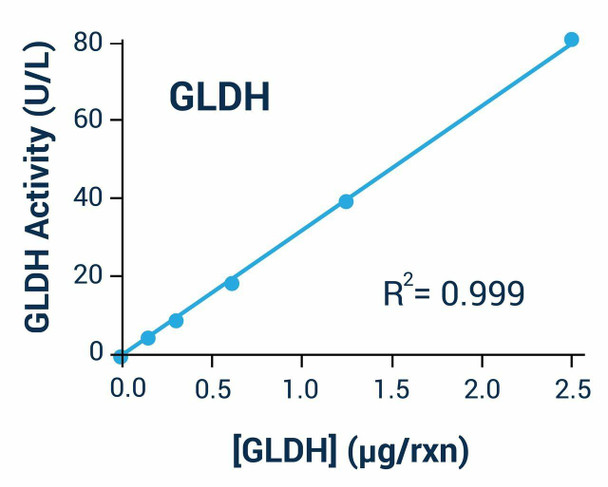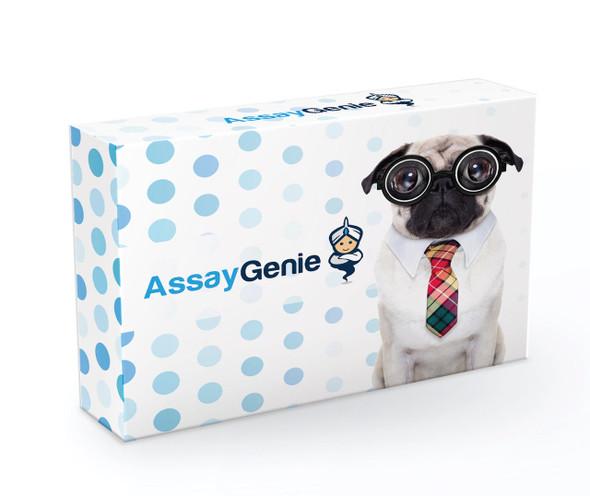Glutamate Dehyrogenase Activity Assay - Information
Assay Genie's non-radioactive, colorimetric GLDH assay is based on the reduction of the tetrazolium salt MTT in a NADH-coupled enzymatic reaction to a reduced form of MTT which exhibits an absorption maximum at 565 nm. The increase in absorbance at 565 nm is directly proportional to the enzyme activity.
Applications
For quantitative determination of glutamate dehydrogenase activity.
Glutamate Dehyrogenase Activity Assay - Key Features
- Fast and sensitive. Linear detection range (20 uL sample): 0.4 to 80 U/L for 30 min reaction. Detection Limit of 0.1 U/L for 120 min reaction.
- Convenient and high-throughput. Homogeneous "mix-incubate-measure" type assay. Can be readily automated on HTS liquid handling systems for processing thousands of samples per day.
Glutamate Dehyrogenase Activity Assay- Data Sheet | |
| Kit Includes | Assay Buffer: 10 mL Diaphorase: 120 uL NAD Solution: 1 mL Calibrator: 10 mL MTT Solution: 1.5 mL Substrate: 1.5 mL 1 M Glutamate |
| Kit Requires | Pipetting devices and accessories (e.g. multi-channel pipettor), clear flat-bottom 96-well plates, centrifuge tubes and plate reader |
| Method of Detection | OD565nm |
| Detection Limit | 0.1 U/L |
| Samples | Serum, plasma, cell, tissue, agriculture etc |
| Species | All |
| Protocol Length | 30 min |
| Size | 100 tests |
| Shelf Life | Store all components at -20°C upon receiving |
| Storage | 6 months |
More Details
GLUTAMATE DEHYDROGENASE (GLDH) is an enzyme which catalyzes the interconversion of glutamate and a-ketoglutarate. Elevated blood serum GLDH levels indicate liver damage; thus, GLDH plays an important role in the diagnosis of liver disease, especially in combination with aminotransferases. Transgenic plants expressing microbial GLDHs are improved in tolerance to herbicide, water deficit, and pathogen infections.
Aliases for GLUD1 Gene
- GlutamateDehydrogenase1
- EC 1.4.1.3
- GLUD
- Epididymis Tissue Sperm Binding Protein Li 18mP
- GlutamateDehydrogenase1, Mitochondrial
- GlutamateDehydrogenase(NAD(P)+)
Entrez Gene Summary for GLUD1 Gene
This gene encodesglutamatedehydrogenase, which is a mitochondrial matrix enzyme that catalyzes the oxidative deamination ofglutamateto alpha-ketoglutarate and ammonia. This enzyme has an important role in regulating amino acid-induced insulin secretion. It is allosterically activated by ADP and inhibited by GTP and ATP. Activating mutations in this gene are a common cause of congenital hyperinsulinism. Alternative splicing of this gene results in multiple transcript variants. The relatedglutamatedehydrogenase2 gene on the human X-chromosome originated from this gene via retrotransposition and encodes a soluble form ofglutamatedehydrogenase. Related pseudogenes have been identified on chromosomes 10, 18 and X. [provided by RefSeq, Jan 2016]
UniProtKB/Swiss-Prot for GLUD1 Gene
- DHE3_HUMAN,P00367
- Mitochondrialglutamatedehydrogenasethat converts L-glutamateinto alpha-ketoglutarate. Plays a key role in glutamine anaplerosis by producing alpha-ketoglutarate, an important intermediate in the tricarboxylic acid cycle. May be involved in learning and memory reactions by increasing the turnover of the excitatory neurotransmitterglutamate(By similarity).
Protein details for GLUD1 Gene (UniProtKB/Swiss-Prot)
Protein Symbol:P00367-DHE3_HUMANRecommended name:Glutamatedehydrogenase1, mitochondrial
Protein Accession:P00367
Secondary Accessions:B3KV55,B4DGN5, Q5TBU3
Protein attributes for GLUD1 Gene
Size:558 amino acids
Molecular mass:61398 Da
Quaternary structure:Homohexamer.
Post-translational modifications for GLUD1 Gene
- ADP-ribosylated by SIRT4, leading to inactivateglutamatedehydrogenaseactivity (By similarity). Stoichiometry shows that ADP-ribosylation occurs in one subunit per catalytically active homohexamer.
- Ubiquitination at Lys 365
- Modification sites at PhosphoSitePlus








